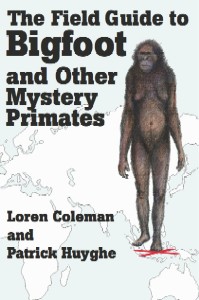Peter Brown on Hobbits, Ebu Gogo, and Bigfoot
Posted by: Loren Coleman on May 21st, 2006
Peter Brown has spoken before of the interrelationship between the media-named "Hobbits," Flores’ ebu gogo, and Bigfoot.
In an interview for Scientific American in 2004, the discoverer of Homo floresiensis was asked,
Certainly by the time of LB1, people had well-developed language and oral traditions. Might encounters with humans like LB1 and other, unknown, island forms be the source of mythologies that are so widespread in the world today involving very tiny people and very large people?
Brown’s reply:
You pick a country and there’s either large Bigfoot and Yetis, or small leprechauns and Yowies, depending on which part of the world you’re in. On Flores there is a mythical humanlike animal called Ebu Gogo, known for small body size, inarticulate speech and an unusual bipedal gait. Every country seems to have myths about these things. We’ve excavated a lot of sites around the world and we’ve never found them. But then last September we found LB1, so surprise, surprise. There’s got to be some overlap in time between [Homo floresiensis] and Homo sapiens. But in terms of oral histories and racial memories and those sorts of things, that’s still a very long time period. Whether people are thinking these things because at one time or other someone actually excavated or found the remains of something small and unexpected I don’t know. But the time periods seem too long–it’s not as if they’re represented in rock art or anything else. Which is not to say there’s not some basis. But I would be surprised. I just think humans have amazing imaginations and they see all sorts of things and create all sort of explanations for things which they half see or maybe see. And a fleeting glimpse seems to mean more than it really should.
It was in this spirit that the editor of Nature, Henry Gee, in an editorial entitled "Flores, God and Cryptozoology," wrote: "The discovery that Homo floresiensis survived until so very recently, in geological terms, makes it more likely that stories of other mythical, human-like creatures such as Yetis are founded on grains of truth….Now, cryptozoology, the study of such fabulous creatures, can come in from the cold."
The 3-feet-tall Homo floresiensis, living on Indonesia’s Flores Island, perhaps do exist today as the small, hairy ebu gogo, the Proto-Pygmies of Flores Island folklore. As noted in my and Patrick Huyghe’s new field guide, Homo floresiensis, while connected in the media in 2004, with Sumatra’s orang pendek, probably has a more direct link with the more fully hairy hominid examples, such as Sri Lanka’s nittaewo.

The front cover of The Field Guide to Bigfoot and Other Mystery Primates is illustrated with a drawing of Homo floresiensis by wildlife artist Richard Klyver, who studied for seven years among chimpanzees in Africa.
About Loren Coleman
Loren Coleman is one of the world’s leading cryptozoologists, some say “the” leading living cryptozoologist. Certainly, he is acknowledged as the current living American researcher and writer who has most popularized cryptozoology in the late 20th and early 21st centuries.
Starting his fieldwork and investigations in 1960, after traveling and trekking extensively in pursuit of cryptozoological mysteries, Coleman began writing to share his experiences in 1969. An honorary member of Ivan T. Sanderson’s Society for the Investigation of the Unexplained in the 1970s, Coleman has been bestowed with similar honorary memberships of the North Idaho College Cryptozoology Club in 1983, and in subsequent years, that of the British Columbia Scientific Cryptozoology Club, CryptoSafari International, and other international organizations. He was also a Life Member and Benefactor of the International Society of Cryptozoology (now-defunct).
Loren Coleman’s daily blog, as a member of the Cryptomundo Team, served as an ongoing avenue of communication for the ever-growing body of cryptozoo news from 2005 through 2013. He returned as an infrequent contributor beginning Halloween week of 2015.
Coleman is the founder in 2003, and current director of the International Cryptozoology Museum in Portland, Maine.










“But I would be surprised. I just think humans have amazing imaginations and they see all sorts of things and create all sort of explanations for things which they half see or maybe see. And a fleeting glimpse seems to mean more than it really should.”
Take a tribe that whose existance depends on their enviroment for generations. Take a group of urban dwellers who does not. Which one is more likely to err on the side of imagination?
Well does it really surpise you? It’s just another skeptical view of something as always. We could of found the pygmie, prime example right here, and they would just debunk it either way.
“Whether people are thinking these things because at one time or other someone actually excavated or found the remains of something small and unexpected I don’t know. But the time periods seem too long–it’s not as if they’re represented in rock art or anything else.”
There are North American stone head carvings, petroglyphs, masks, and pictographs representing the “hairy man”, just to start. I respect Brown’s position but I think there is a lot of possible evidence getting overlooked…
A little close-minded I think he is.
re: #3
I believe Brown, from the context, is speaking exclusively on h. floresiensis
re: #4
I don’t presume to know Brown’s predilections, but I also don’t presume to put words in his mouth. He HAS seen fit to grace Cryptomundo with an exclusive interview though. Just because he thinks “ebu gogo” traditions and homo floresiensis remains on the same island are unrelated doesn’t mean he is “close-minded.”
You will note that there are some who insist there is only one type of unknown large hominid, while others insist the evidence points to a variety of types.
Close-mindedness, skepticism and belief are not absolutes. They come in degrees.